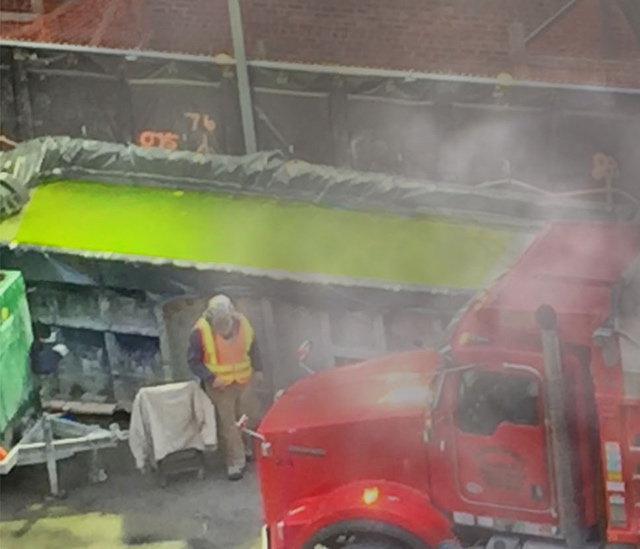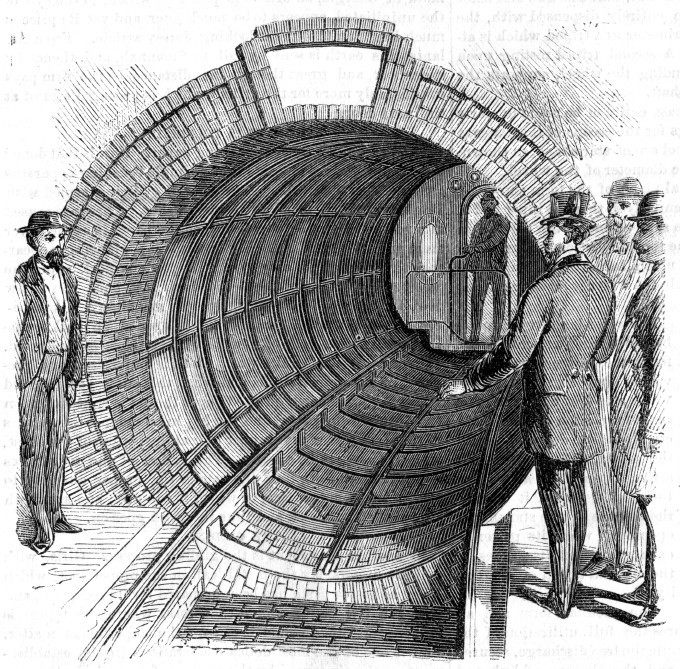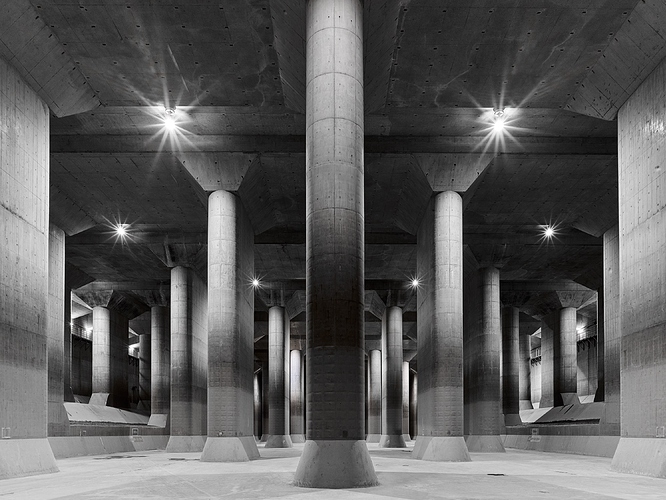RAY: Mr. Mayor, we are here tonight because a psychomagnotheric slime flow of immense proportions is building beneath the city.
EGON: Negative human emotions are materializing in the form of a viscous, psychoreactive plasm with explosive supernormal potential.
From " Ghostbusters II ", written by Dan Ackroyd and Harold Ramis, 1989
December 12, 2018 - New York, NY - Say, What’s In This Dumpster Full Of Mysterious Green Stuff The MTA Dredged From The L Train Tunnel?
One resident told Gothamist / WNYC on Monday that the dumpsters near his apartment housed a strange, bright green substance , and when he questioned the MTA about its exact makeup, they claimed it was water, concrete, and dirt .
Hm, let’s take a closer look…
(Dumpster full of “mysterious green liquid” dredged up from the L train tunnel in New York, December 2018)
As you can see in the news account immediately above, the folks in charge are not your friends, and are lying to you about basically everything, including the green slime down in the L train tunnel.
I’m sure you remember the river of slime in the disused subway tunnel beneath the streets of New York in Ghostbusters II:
[image]
(The Ghostbusters examine river of slime in Ghostbusters II, 1989)
“Aykroyd and Ramis…wanted to convey a message about the consequences of negative human emotions in large cities . They settled on the idea of negative feelings creating a mass of supernatural slime beneath New York City, which empowers malevolent spirits .”
This is mapping directly to my recent research suggesting that it is high concentrations of Death energy in cities that drives levels of crime and mental illness there that are exponentially higher than those seen in rural areas.
“While Peter and Dana have dinner, Egon, Raymond, and Winston explore the underground river of slime and are pulled in. They begin fighting until Egon realizes they are being influenced by the slime .”
In the film, the underground river of slime is in Alfred Beach’s accurately depicted “Pneumatic Subway” tunnel from 1873.
Beach’s subway handled 400,000 rides in a year…and the Rolling On The Floor Laughing official story as to why it quickly closed was " the stock market crash and financial and political woes shut down the project ."
The truth is that they just wanted an excuse to dig the Death energy container. The fact that it was depicted for what it was in Ghostbusters II is an insider wink.
Coincidence theorists must also note that " the stock market crash " and " financial and political woes " are both general .
As you may recall, generality is a hallmark of propaganda.
I will now segue to an article below from 2012 from the very heart of darkness, Washington, D.C., headlined " A Long-Forgotten ‘Tunnel of Slime’ Under Washington ."
It tells the story of the Washington City canal:
"It wasn’t doing that well to begin with, but then the railroad totally put it out of business.” In the meantime, the city’s residents had begun using the Canal… as a sewer. “It was disgusting,” Bender says. “By the 1870s, it was a terrible public health problem and then enter Boss Shepherd, [who] created this territorial government and became the leader of the territorial government.”
Shepherd was responsible many public improvements to the city, from paving roads and adding streetlights to planting trees around town. “He also made it his business to do something about the Washington City Canal, which is now this disgusting, smelly thing,” Bender says. “And he used an engineer, a German immigrant named Adolf Cluss, and Mr. Cluss put the canal underground.
He built a giant tunnel and diverted the water right into this tunnel…So now we have what Bender likes to call “ a tunnel of slime” beneath the city . According to some reports, the tunnel is large enough to drive a bus through ."
So I’ve been working on this article for about half an hour (while watching the original “Ghostbusters”, from 1984, I kid you not), and I’ve already got one cinematic depiction of a tunnel of slime and two actual tunnels of slime.
No one’s got this kind of content, baby, no one.
(In Brooklyn accent) “Extra, extra, read all about it…Miller tells all in slime tunnel expose…read all about it!”
See, the slime tunnel is a Death energy generator, battery, and distribution system, all rolled into one.
To maintain current programming levels, stop reading immediately and affirm “there is no such thing as the Ether.”
The great drops in crime that have been taking place of late regardless of locale prove that it is the condition of the Ether that is the most important determinant of the mental health of those within it. Mental and moral health improve and decline as the health of the energetic environment does.
These Municipal Death energy generation and distribution systems are an ancient technology, going back to the sewers of Paris, and back again to the Catacombs of Rome.
Check out the pic below of Tokyo’s brand new water management system and compare it to the one of the ancient basilica cistern in Istanbul.
Jeff Miller, Brooklyn, New York, February 28, 2020
If you’d like to be added to the mailing list, or know someone who would be, please send me a note at [email protected]
February 24, 2012 - METRO CONNECTION
The Location: A Long-Forgotten ‘ Tunnel of Slime ’ Under Washington
Back in the early 1800s, had one wandered around the area that is now 17th Street and Constitution Avenue in Northwest D.C., he or she would have had a direct waterfront view of the Potomac River. That’s because the Potomac used to extend nearly all the way to where the Washington Monument stands today.
“Because once upon a time,” says Kim Bender, author of the blog, The Location, Washington D.C., had a lot more water in it than what we know the city to look like now.”
Indeed, not only did the Potomac’s banks use to extend even farther, but also Constitution Avenue used to be a body of water. It was called the Washington City Canal and it was built in the early 1800s to connect the Anacostia River, then known as the Eastern Branch, with the Potomac.
“Because [with the] Anacostia, you kind of have access to Maryland,” Bender says. “And then through the Potomac you had access to the West.”
Plus, by the 1830s, the Washington City Canal connected to the Chesapeake and Ohio Canal, that visionary waterway that many believed would eventually provide access all the way to Pittsburgh.
And that, says Bender, brings us to the overlooked location on Constitution and 17th. It’s the 30-foot-wide, 18-foot-deep Lockkeeper’s House: a one-and-a-half-story stone cottage erected in 1833 when the C&O Brand extension was completed.
Changes to the Potomac and C&O Canal
As Bender explains, “they needed a lockkeeper to take the tolls between the two canal systems and to keep records of the commerce. By the 1850s, though, nobody was really using these canals anymore because of the railroads. That was really the technology of the future.”
And the truth is, Bender says, “the Washington City Canal was never that great to begin with. It was beset by problems from the start.”
For one, it was too shallow. Also, the engineers who built it didn’t take into consideration the tides of the Eastern Branch, or the Anacostia River.
“Sometimes the water would overflow the banks, and sometimes the water would be impossibly shallow,” Bender says. “So it wasn’t doing that well to begin with, but then the railroad totally put it out of business.”
In the meantime, the city’s residents had begun using the Canal… as a sewer.
“It was disgusting,” Bender says. “By the 1870s, it was a terrible public health problem and then enter Boss Shepherd, [who] created this territorial government and became the leader of the territorial government.”
Shepherd was responsible many public improvements to the city, from paving roads and adding streetlights to planting trees around town.
“He also made it his business to do something about the Washington City Canal, which is now this disgusting, smelly thing,” Bender says. “And he used an engineer, a German immigrant named Adolf Cluss, and Mr. Cluss put the canal underground. He built a giant tunnel and diverted the water right into this tunnel. Then they filled in the Washington City Canal and named it B Street. Now it’s known as Constitution Avenue, but for a while, it was B Street and that would’ve been its letter on L’Enfant’s plan.”
(Where did the tunnel go? People at the time wouldn’t have stood for “it goes to nowhere”, had they been briefed. The guy deliberately built a Death energy generator under the guise of “public works”. - ed)
History of the Lockkeeper and his house
So now we have what Bender likes to call “ a tunnel of slime ” beneath the city. According to some reports, the tunnel is large enough to drive a bus through . And now, the Lockkeeper’s House is the last visible indicator of the Washington City Canal. The National Park Service owns the house, and uses it for storage.
As for the lockkeeper himself, Bender says some accounts report he had 13 children who lived in the house. She also found a 1976 interview with a man named Otho Swain. He was born in 1901 on a canal boat. His father worked on the canal, and his grandfather helped build the C&O. Swain says his grandfather “actually met his wife, the lockkeeper’s daughter, who lived in this house.”
( 13 children a controlled-press callout, letting you know the lockkeeper was a generational Satanist. Bet you he was in charge of getting the bodies into the slime tunnel, to keep it “charged up”. - ed)
So perhaps this modern-day “tunnel of slime” could also be called a Tunnel of Love .
March 28, 2014 - Beneath Paris’ City Streets, There’s an Empire of Death
April 7, 2017 - Check Out Tokyo’s Cavernous, Creepy , Totally Sci-Fi Drainage Tunnels
April 9, 2017 - The Creepiness of the Basilica Cistern, Istanbul, Turkey
[image]
March 8, 2019 - Making the Most of the Underground Real Estate:
On comes the King! King Louis XIV, that is. In 1777 he decides to set up a royal commission to map out the quarries and strengthen tunnels where needed. The Inspection Générale des Carrières (IGC) is formed and men begin the tedious and dangerous task of saving Paris from its ancient tunnels, digging new access tunnels to reach the toughest spots.
Mapping the underground tunnels sparks another idea in the King’s mind, as he is facing unrest from the people of Paris. You see, Paris of the late 18th century is a filthy place with sewage running in the streets, fresh water contaminated and the cemeteries overflowing. There is simply no more room to bury the dead, especially in the big cemetery in the center of town, in what is now Les Halles. Centuries of human settlement, wars and plagues – have rendered the cemeteries completely full and the stench is unbearable !
The king orders the cemeteries to be emptied out and moved underground where real estate is plentiful and now partially mapped! Until 1859, it is estimated that 7 million bodies are exhumed and transferred below ground , from more than 150 cemeteries. Centuries of deceased Parisians are piled into the old quarries. Legend has it that one undertaker counted 70,000 bodies that he alone transferred underground.
(Here, as in the Washington, D.C. “Tunnel of Slime”, previous, the establishment guy crows that he’s engaged in “public works” as he builds the Death energy generator. Moves 7 million graves to get all the bodies concentrated in one place, the biggest possible Death energy producer/battery that could be devised. - ed)
October 21, 2019 - 10 Creepy Things You Didn’t Know About The Paris Catacombs
it’s not a far stretch to think some of the tunnels might be filled with water.
2020 - The Dark Side of Rome: Catacombs & Mysteries Combo Tour by Night
Emerge back into the light of day and head to the Basilica San Clemente. Hear the tale of a priest driven mad by the sound of running water who dug into the floor of the church to uncover a first-century Roman aqueduct . Continue on to the grotesque Capuchin Crypt, also known as the Bone Chapel. The exhumed bones of over 4,000 monks adorn the walls and ceilings here in a macabre display of deathly décor, including dangling chandeliers made from vertebrae and skeletons still wearing their habits .


